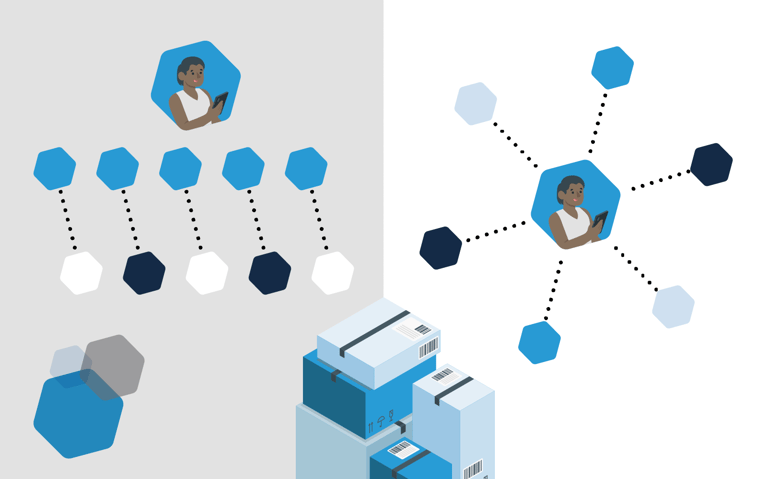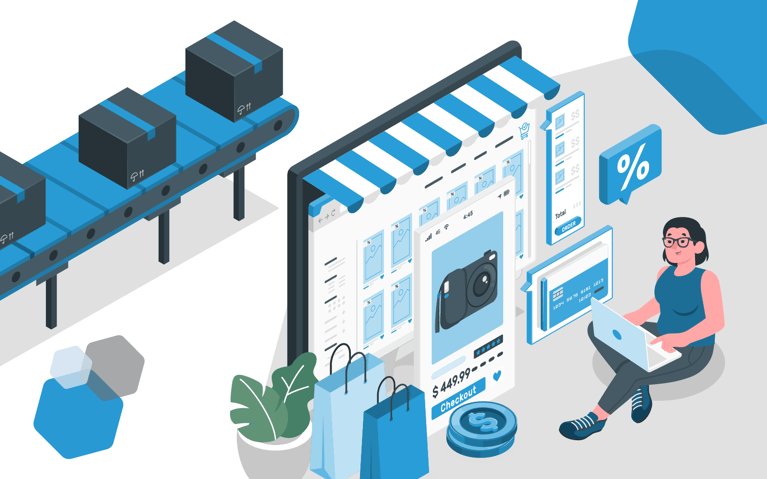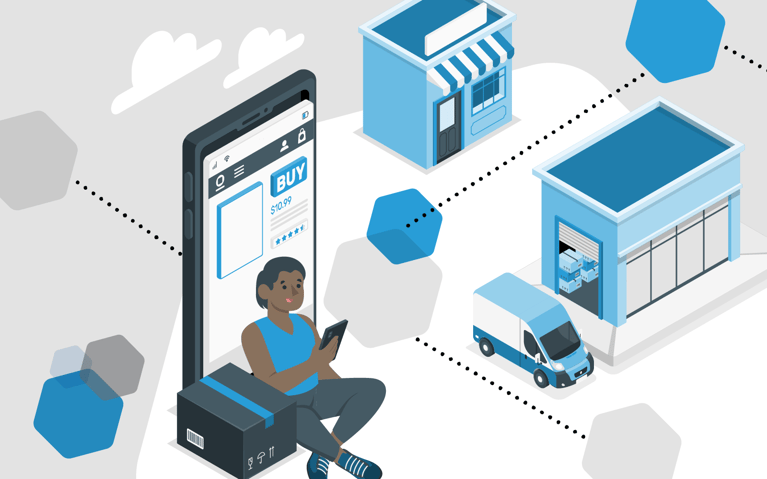As ecommerce continues to rise, the fulfillment industry is set to grow at a compound annual growth rate of 13.9% between now and 2030. Online retailers rely on fulfillment to manage inventory and returns, track order data, pick, pack, ship and get packages swiftly through the last mile and into the hands of the customer.
With the amount of products shipped, it's not uncommon to wonder if self-fulfillment is a good option. In-house fulfillment empowers you to handle your product on your terms. However, outsourced fulfillment is still attractive, offering a multitude of benefits. So, how do you decide which is right for you?
The answer isn’t simple. Both offer different benefits. Often, the decision comes down to cost, labor, time, space, sales and size. And it’s not a decision to take lightly, especially since the fulfillment process enormously impacts the customer experience. It all comes down to what’s best for your business. So, let’s dig in and find out.
How are self-fulfillment and outsourced fulfillment different?
Both self-fulfillment and outsourced fulfillment involve the same operations:- Storing inventory
- Processing orders
- Picking and packing
- Shipping
- Last-mile delivery logistics
- Reverse logistics
- Customer service
- Data reporting
Self-fulfillment (or in-house fulfillment)
When an ecommerce brand manages their fulfillment process. They hire and manage their own labor to conduct fulfillment operations. They source warehouse space and procure packaging materials.Outsourced fulfillment
When a brand uses an outside third-party logistics (3PL) to manage fulfillment for them. They can be responsible for some or all of the process. They have the space, labor, materials and technology to handle orders from checkout to delivery.
Ecommerce brands can outsource some or all of their fulfillment operations. Many modern 3PL providers have technology and integrations that streamline data and provide real-time insights into a brand’s processes.
Retailers can select from services such as:
Warehousing
Ecommerce businesses outsource warehousing to 3PLS to receive and store inventory safely until needed. Some outsourced warehousing is equipped to store specialized items – for example, heat sensitive – to maintain product integrity or items that require sequencing, such as First In, First Out (FIFO). During peak season, additional storage for seasonal inventory is often necessary.
Another warehousing service is multi-node fulfillment. Some retailers only need a centralized warehouse location to store their inventory, while others may use a multi-node network that places SKUs at several facilities close to important customer hubs.
Inventory management
Proper storage, efficient monitoring, and accurate reporting of Stock Keeping Units (SKUs) are crucial for maintaining an organized product catalog. Retailers must ensure they don't run out of in-demand items and miss out on sales opportunities or end up with surplus inventory by ordering too many units. Using a reliable 3PL, retailers can obtain detailed inventory reports that prevent overselling merchandise and set appropriate reorder points.
Order fulfillment
Order fulfillment is the process of getting an order ready for shipping. This involves:
- Handling orders from your online store or multiple sales channels
- Picking (selecting) items
- Packing while adhering to brand requirements
- Shipping and last-mile delivery
Order fulfillment uses ample time and resources – and as order volume increases, it can become necessary to outsource.
Reverse logistics
Eighty percent of consumers say returns management is the most important factor when considering the overall order experience, making returns management crucial for today’s ecommerce retailers. Retailers must be able receive, process and recondition items for resale swiftly. Otherwise, refunds are delayed, or you end up with dead stock, which can cost you both customers and valuable resale opportunities.
Customer support
3PL providers are experts in fulfillment. When working with brands, they can offer insights and expertise along with support. When performing fulfillment in-house, you are negotiating costs with carriers and having to stay on top of industry trends. An excellent 3PL partner will help you perform these functions. Having seen the challenges and solutions in the industry, they are often able to help strategize packaging, storage and more. If you use their OMS and/or WMS, you'll have support there as well.
Pros and cons of self-fulfillment
Choosing self-fulfillment will often depend on your size, scope, number of products and other factors. For example, a small startup with one product that only sells 100 units per month will likely choose to self-fulfill. On the opposite end, a major international brand may have a number of their own fulfillment centers. However, keeping fulfillment in-house comes with both pros and cons:
Pros
- Direct control over the entire fulfillment process: A company is heavily invested in its success – which makes staying in control of your operations beneficial. When people are aligned, they can provide a uniform service that promotes the same mission. In fulfillment, this means handling the process in a way that matches the brand's mission and value. It also allows you to respond and adapt quickly, whether it is customer feedback or a process that’s not working.
- It’s straightforward for young retailers: In the early days, it’s often more cost-effective and easier to handle fulfillment yourself. Brands can store in a house, garage or office until they build up business.
- The ability to customize and personalize: Self-fulfillment empowers brands to explore packaging in ways that personalize the brand experience. Ecommerce retailers that self-fulfill have gone as far as writing handwritten notes and adding extras. Having fulfillment in-house lets you try new things on a whim.
Cons
- Cost: While you can save costs with in-house fulfillment, you can also run into hidden costs, especially as a business scales up. You begin to require more inventory and storage and may even be trying to handle it yourself manually. Costs can swiftly ramp up as you try to increase productivity.
- Peak season challenges: Retailers love peak season. It’s often a time of abundant sales and an opportunity to create brand awareness. That said, if you don’t have the right amount of materials, labor or other resources in place, you may be unable to keep up with demand. You might even lack a place to store extra stock.
- Time demands: Businesses are busy. There is a lot to juggle to succeed and grow. Fulfillment is a time-consuming process – as you sell more, the time it takes to manage orders increases. Getting products to your customers promptly is a large part of customer satisfaction.
Pros and cons of outsourced fulfillment
Many retailers are happy to hand over fulfillment operations and let a 3PL do the heavy lifting. That said, outsourced fulfillment is not for everyone.
Pros
- Scale your business faster: An outsourced fulfillment service can help you scale faster. Whether it’s creating a multi-node network or increasing labor, they have the resources in place to help you expand quickly and meet customer needs in the timeframe they expect.
- Allows you to focus on marketing, business operations and growth: Fulfillment takes time that can otherwise be spent innovating, strategizing and implementing processes that streamline your company. When you outsource fulfillment, it gives you more space to handle the things that drive growth.
- Cost-effective: Working with a 3PL can save you money. There may be more opportunities for bulk pricing, or a provider can negotiate better prices on your behalf. A 3PL provider may also have current technology that you couldn’t access that streamlines your business better, and helps drive more informed decisions.
- State-of-the-art technology: You can leverage new fulfillment innovations, automations and other technology as well as the 3PL’s expertise.
- More flexibility: A 3PL provider can offer flexibility you may not otherwise have. For example, handling peak season, even when demand exceeds forecasts.
Cons
- Cost: Outsourced fulfillment may not make sense with low order volumes. It is best to outsource when the benefits outweigh the cost.
- Letting go of control: Outsourcing means letting someone else step in to do the job – and that’s control some retailers aren’t comfortable giving up.
- Finding the right 3PL partner: Each 3PL is different. Understanding your needs and matching with a provider that can best serve them is critical. This might mean a multi-node network, specialty storage or available tech integrations.
Outsourcing your fulfillment effectively
If outsourced fulfillment to a 3PL is optimal, take steps to ensure success. Let’s say you’ve assessed that outsourcing is the best option: For example, growth is hindered, you’re too heavily involved with fulfillment, there are fulfillment issues, you’re ready to hand over the reins or it makes financial sense.
Begin the process by assessing your needs regarding products, order characteristics, sales channels and customer expectations. Next, compare the different outsourced fulfillment models. Last, find the fulfillment partner that best fits your needs.
Contact us today to find out if Cart.com is the right outsourced fulfillment solution for you.
Subscribe to our emails for the latest industry insights!
By entering your email, you agree to receive marketing emails from Cart.com






